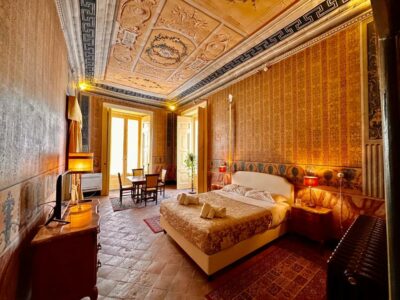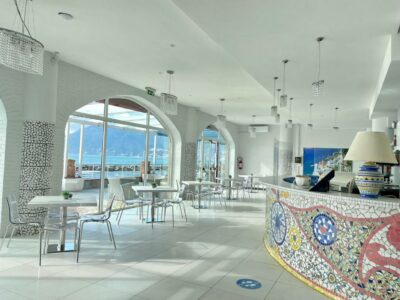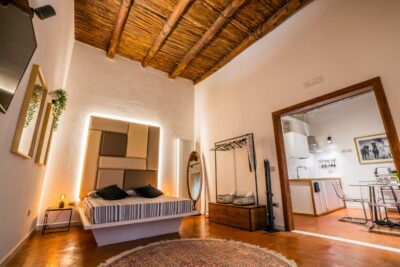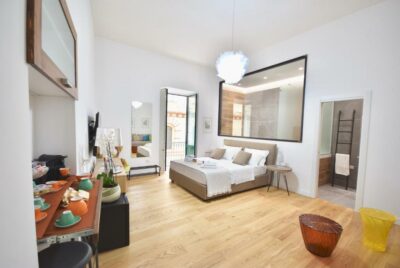Strategically located between the Amalfi Coast and the Cilento Coast, the city of Salerno has become very famous in recent years for Luci d’Artista, the event that fills the city with lights and magic during the Christmas period.
Since the Amalfi Coast is not served by train services, Salerno is a compulsory stop for those travelling by train: in fact, it is from here that buses and ferries leave to reach the various destinations on the Coast.
In fact, in addition to the event just mentioned, the city holds many attractions to visit, not to mention the pleasure of strolling around the centre, browsing in shops and clubs.
In this article we will provide you with all the information on the city of Salerno: read it to the end, to discover plenty and find interesting ideas to complete your travel itinerary.
We bet you will decide to stop in Salerno at the end of the article?
Indice dei contenuti
How to get to Salerno
✅ If travelling by car, you can reach your destination from Rome via the SS7, while from Naples take the A3 motorway, exiting at Cava de’ Tirreni and continuing to Salerno.
✅ If you reach the city by train, you can travel by Regional Train, Intercity, High Speed or Italo.
✅ From Naples you can travel by Sita Sud services: the bus leaves from the terminus located at Varco Immacolatella.
Other private companies are also available to provide transport from Naples and Salerno, such as MarinoBus, Flixbus and Itabus.
✅ If, on the other hand, you are leaving from the Amalfi Coast, you can reach our provincial capital by travelling on Sita Sud buses: the buses leave from Amalfi and make all intermediate stops as far as Salerno. You can purchase tickets at all Unico Campania retailers or using the Unico App.
From April to November you can enjoy the journey by sea with the Travelmar company: ferries leave from Amalfi and stop in Minori, Maiori, Cetara and Vietri. The journey from Amalfi to Salerno takes about 50-55 minutes. We recommend this option, especially if you are travelling in high season, because it avoids traffic and shortens journey times, not to mention the pleasantness of the sea journey.
📣 Your road free from queues: book the ferry!
If you would like all the information you need to get around the Amalfi Coast like a true local, download our free guide “How to get around the Amalfi Coast without stress”. Inside you will find everything you need to know to organise your travel itinerary in the best possible way, avoiding traffic, full car parks, and missed connections!
Where to sleep in Salerno
📣 Looking for accommodation in Salerno?
Here’s a selection of the best establishments for you!
What to see in Salerno
As we already mentioned in the introduction to this article, Salerno has become famous for Luci d’Artista, the event that populates the streets of the city centre with lights, merriment and social life every year throughout December and part of January.
We know that if you ended up on this page, you were probably looking for collateral information to find out more or to organise a city break at Christmas time.
📣 However, we invite you to read this section carefully: we will amaze you by showing you virtually all the things you can discover while wandering around the city. Before we leave you with the list of Salerno’s best attractions, we invite you to read the article we have written to propose a one-day itinerary to discover the city: not to be missed if you are planning a short stopover to move on to the neighbouring towns.
Ready? Let’s go!
📍 The historic centre
It is impossible not to start with the historic centre, the heart and core of the old city. Salerno poet Alfonso Gatto called it a ‘Medieval Jewel’, alluding to all the traces of antiquity still visible among the historic buildings and intertwining alleyways.
Strolling from Via Vittorio Emanuele, the city centre where the shops and main activities are concentrated, you reach the charming Via dei Mercanti, where you feel the ancient heart of the city beating.
Here, amidst small shops and craft workshops, glamorous establishments and small local delicatessens, you will trace elements of Salerno’s glorious past. One thing that will strike you along this street will be the murals dedicated to the poet Alfonso Gatto: writings, excerpts of poems and images cover the walls and doors of a small alleyway that leads, via a lift, to the Giardino della Minerva, an attraction we will tell you about shortly, in this very section.
📍 The Cathedral of Salerno
The Cathedral of St. Mary of the Angels, St. Matthew and St. Gregory VII was built in Romanesque style in the 11th century and underwent several restorations over the centuries.
The façade and staircase leading to the church are in Baroque style. The external portal is called the ‘Lions’ Gate’: you will notice, in fact, on one side, a lion representing strength, on the other a lioness with her cub, symbolising charity.
In fact, the entire outer façade features depictions of animals: for instance, on the far side of the architrave you can see a monkey and a lion. The portal leads into a Romanesque four-sided portico, which together with the Cathedral of Sant’Ambrogio is unique in Italy. Inside the portico are several tombs, such as that of Capograsso, which bears a decoration inspired by the Rape of Ariadne, that of the Countess of Durazzo and that of Duke William.
The interior of the Cathedral has three naves, the central one of which is surmounted by a barrel vault. The overall style is 17th century, but traces of Giotto frescoes have been found in one of the naves, testifying to its medieval past. At the end of the nave is a wooden choir bordered by two ambos supported by typically Byzantine columns decorated with an inlay of polychrome stones.
The sacristy leads to the treasure chapel, with a remarkable frescoed ceiling depicting the so-called Paradise of Salerno, created by the painter Filippo Pennino. In the chapel, you can also admire the silver statues of the patron saint, Pope Gregory VII, the Salernitani Martyrs and the solid wood statue of St Joseph.
Not to be missed, for its artistic value, is the crypt, which houses the remains of St. Matthew, the city’s patron saint. Definitely worth admiring are the frescoes by Belisario-Corenzio, a late Mannerist painter: they depict scenes from the Gospel of Matthew and episodes from Salerno’s history.
In the centre of the crypt you can admire the tomb of St Matthew.
📍 The Minerva Garden
In the heart of Salerno’s historical centre, in a position from which you can enjoy a beautiful view of the entire city, is this splendid botanical garden, where many botanical species related to the famous Salerno Medical School are preserved. The garden, in fact, was created in the 13th century by Matteo Silvatico, a doctor of the the famous “Scuola Medica Salernitana”, who decided to collect all the plants used to cure illnesses in this educational space.
The walk through the garden is very relaxing and pleasant: the atmosphere is peaceful and quiet, a small oasis of peace far from the bustling city life.
In addition to the different sections of the botanical garden, you can also visit the Pharmacy Museum, where some tools, period instruments and historical manuals are preserved.
In addition, you can sip herbal tea at the delightful café inside the building.
The Minerva Garden is accessible from Tuesday to Saturday, from 9.30 a.m. to 4 p.m.
📍 Provincial Art Gallery
In Via Mercanti, 63 is a 17th-century historical building, Palazzo Pinto, which houses a splendid art collection divided into three sections, dedicated respectively to painters from Salerno, coasters and foreign artists. The works housed and preserved at the Provincial Art Gallery cover a time span from the Renaissance to the early 20th century.
Among the most valuable works, you can admire those by Andrea Sabatini, one of the most important artists of the southern Renaissance, or those by Francesco Caracciola and Francesco Solimena.
We recommend the stop, because if you decide to explore the historical centre, it is practically on your doorstep. Moreover, admission is free.
📍 Monumental Complex of Santa Sofia
In Piazza Abate Conforti, not far from the cathedral, you will find the Monumental Complex of Santa Sofia. This is a monastery dating back to the 10th century. The building was first the seat of the Benedictine order dedicated to St Sophia. It was later handed over to the Jesuits, until Pope Clement suppressed the order in 1778. It was later a civil court and then a school building.
The monumental complex was recently renovated after years of neglect: today it is the venue for events and important art exhibitions.
📍 Medieval Aqueduct
In the heart of the centre, more precisely in Via Fiera Vecchia, pay attention to these very special arches: they are nicknamed ‘Devil’s Bridges’, because according to legend they were built in a single night with the help of the devil. Even today, it is said that venturing under this construction at night exposes one to the risk of encountering evil spirits.
In reality, it is an aqueduct dating back to the 10th century, built to provide the monastery of St Benedict with water.
📍 Villa Comunale
It is located at the entrance to Salerno, coming from Vietri sul Mare. This welcoming and lush garden was built in the late 19th century and offers a green oasis in the heart of the city.
It is absolutely worth visiting during the period of the aforementioned Luci d’Artista: it is here that the most peculiar and Instagrammable installations are displayed. In fact, at this time of year the Villa Comunale takes on the name of ‘Enchanted Garden’, a name that well sums up the amazement one experiences walking among the splendid light installations. A must-visit if you are travelling with children.
Add to this the fact that in summer, the Villa Comunale guarantees some coolness from the scorching heat. If you stop here during the summer months, take advantage of a refreshing slush at the kiosk inside the garden: it is said to be one of the best in Salerno.
During the summer months, we recommend having mosquito repellent with you.
📍 Piazza della Libertà
In the Santa Teresa area, after having walked all the way along the Salerno seafront, you will come across this splendid square, which was built very recently.
Piazza della Libertà was, in fact, officially inaugurated in September 2021.
It presents itself as a vast area overlooking the sea and hosts a car park with 700 parking spaces in the underground area. The project includes the renovation of the waterfront and harbour area and the opening of some activities in the buildings constructed around it. Although the area is still sparsely populated with commercial activities, we recommend a stop at the cosy seaside café, which is located at one end of the square, in a very pleasant position, especially at sunset.
There is also a small playground equipped for the little ones.
📍 The Castle of Arechi

To visit it, you have to move a little way from the centre. In fact, the Arechi Castle is about 300 metres above sea level and is easily reached from the station by taking the Cstp urban bus line 26. The stop is De Renzi 8 (it is about 18 stops from the starting point).
✅ If you are travelling by car, from the A3 you must follow the signs for the Amalfi Coast and then those for Castello Arechi.
✅ If, on the other hand, you are coming from Rome, once in Salerno, take the turning for via Alfonso Gatto and from there follow the signs.
You can also easily reach the castle on foot, walking through the historical centre, but we will talk more about this in the next section, dedicated to trekking.
Once you arrive at your destination, you will find yourself in front of a medieval castle, built around the 6th century.
In fact, the fortress gained importance in later centuries, when it became a fundamental element of the city’s defence system.
In addition to admiring the building, with its crenelated walls and drawbridges, you will also see the Bastille Tower, located to the north of the castle, which once served to ensure control over the southern side of the castle.
Inside the building, on the other hand, you can visit the Archaeological Museum, where some important finds are kept, and the Multimedia Museum, which offers the opportunity to learn about Salerno’s medieval history through videos, simulations and digital material.
The Castle is accessible from Tuesday to Sunday, from 9am to 5pm.
📣 If you are looking for more information, we recommend you read our in-depth article on the Arechi Castle.
What to do in Salerno
📍 Sentiero del Principe (Prince’s Path)
We have already told you that the Arechi Castle can also be reached on foot through the heart of the city. The path starts at the Cathedral of Salerno, climbs pleasantly towards the upper part of the city and first reaches the pine forest in front of it and then the Castle and the Bastille, further up.
From here you can proceed to the destination Croce di Cava and then descend gently towards Salerno. On the way back you will come across the so-called ‘Cornice del principe’ (the prince’s frame), the remains of an ancient building, probably a chapel, positioned in an incredibly panoramic spot, which seems to be perfectly framed by this window looking out onto infinity.
📍 Monte San Liberatore
Rises to a height of about 466 metres and serves as a connecting point between Salerno, Cava de’ Tirreni and Vietri sul Mare. On the summit is the hermitage dedicated to the saint and a cross, a gift from a believer in the 1950s, which is illuminated at night and is visible from both Salerno and Cava de’ Tirreni.
To reach your destination, start from the centre of Salerno, walk through the heart of the city and slowly continue from Rione Canalone, until you reach the top of the mountain. The walk is not very strenuous, except for the last stretch, which requires a minimum of training because it is more challenging.
Experiences to do in Salerno
📣 Your trusted locals have selected the best experiences in and around Salerno for you!
The city of Salerno really does offer a vast choice of experiences to enjoy the area and spend carefree moments.
First and foremost, shopping. You have to know that for us on the Coast, the city of Salerno is a reference point for shopping and services that our small towns lack.
The city centre, from Via Vittorio Emanuele to Via Mercanti is teeming with shops: large chains, luxury brands, and historic shops alternate with restaurants, clubs, delicatessens, and streed food shops, composing a varied mosaic that is sure to delight those who love shopping and city life.
A carefree stroll through the streets of the centre is therefore a must, especially if your trip coincides with the Christmas period: in the month that hosts Luci d’Artista, the waterfront area also comes alive with handicraft stalls, where you can find every regional delicacy and many gift ideas.
During the evenings, especially at weekends, the nightlife of the nightclubs kicks off: from those hidden in the tangle of alleyways in the old town centre, to those overlooking the seafront, you really are spoilt for choice, whether to eat, drink or dance.
There are also organised tours in the city that accompany travellers and tourists to discover the most interesting places.
📣 If you stay for several days, you also have other options: you could, for example, book a boat tour to Capri or the Amalfi Coast, or explore the temples of Paestum, taking advantage of a gastronomic stop at one of the many producers of buffalo mozzarella.
In short, the choice is vast!
Events in Salerno
Both in summer and winter, city life is enlivened by many cultural and entertainment events. In this section we list the most important ones, but remember that the summer programme is often very rich: always take a look in advance to see if there are any events that might interest you. Besides Luci d’Artista, which we have already told you about, here are the most important events you will find in Salerno:
✅ The festival dedicated to the patron saint On 21 September, St Matthew, the city’s patron saint, is celebrated. During the festivities, the statues of St. Matthew, Pope Gregory VII, St. Joseph and the statues of the three martyrs St. Caius, St. Ante and St. Fortunatus, known by the Salernitans as the ‘three sisters’ of St. Matthew, are carried in procession.
The procession starts from the cathedral and proceeds along Via Duomo and other streets in the centre, ending with the traditional and evocative run down the stairs back to the cathedral. The main dish of the feast of St Matthew is spleen – in dialect ‘A’ mevza ‘mbuttunata’ – a dish of ancient popular tradition, prepared with veal spleen, plenty of parsley and wine vinegar.
✅ The Fair of the Rediscovered Crucifix An event that animates the heart of Salerno, which kicks off during the month of April. The event originates from an ancient medieval fair that brought merchants from all over the south to the city. Today, the festival includes historical re-enactments, processions that animate the city streets and handicraft stalls.
✅ Mostra della Minerva: an exhibition-market dedicated to plants usually held in the first ten days of April at the city’s Villa Comunale.
✅ During the Christmas period, keep an eye on the events taking place around the city. We also recommend the New Year’s Eve Concert, which hosts national celebrities every year.
✅ During the summer, there is never a shortage of cultural and musical events, theatre performances and festivals.
Why choose Salerno as a travel destination
The city of Salerno is strategically located between the Amalfi Coast and the Cilento Coast. This, combined with excellent transport links, makes it a winning destination if you are looking for a convenient base to stay several days and visit different locations.
📣 Remember that in about 50 minutes by car, an hour by bus and 40-50 minutes by train you can also reach the city of Naples.
🔹 The city of Cava de’ Tirreni is also very close, just 8 km away.
📣 Choose Salerno as your travel destination if:
🔹 you are looking for a convenient destination that allows you to have all services at your fingertips and to move easily to visit the Amalfi and Cilento coasts;
🔹 you want to enjoy the nightlife: Salerno is teeming with clubs and restaurants open until late at night.
🔹 you are looking for a less touristy travel destination with more convenient accommodation options.
The best time to visit Salerno
The best time to visit the city is definitely around the Luci d’Artista event, a period that usually runs from early December to the first half of January. Keep in mind, however, that the closer you get to the Christmas festivities, the more the city becomes populated with tourists and travellers: from 8 December onwards, in the evening hours you are very likely to find yourself bottled up in the city traffic and take a long time to reach your destination.
If you visit the city at this time, the advice is to walk the short distances or travel by public transport.
If you visit the city at another time and your intentions are to extend your trip to the Amalfi Coast, we advise you to take the traffic factor into consideration here too: in high season it can be difficult to reach the Amalfi Coast by car, especially at weekends. One solution could be to leave your car in Salerno and reach other destinations by travelling on Sita buses or using Travelmar services.
Curiosities about Salerno
✅ The two faces of St Matthew The statue of the patron saint has two faces, to which various legends have been linked over the centuries in an attempt to give an explanation. One reason for the two faces would be linked to the dual nature of the saint, first a tax collector and then an evangelist.
According to other explanations, St. Matthew’s two faces would be a metaphor for the double face of the people of Salerno, capable of adapting to the most diverse situations. Finally, a third version links the two faces to the city’s position, wedged between the sea and the mountains.
✅ Trotula de’ Ruggiero There are numerous accounts of the existence of Salerno women, the so-called ‘mulieres salaernitanae’, who practised the profession of healer during the Middle Ages. Prominent among them is Trotula, an exponent of the Salerno School of Medicine, to whom is attributed the work ‘De passionibus mulierum ante in et post partum’, a veritable treatise on obstetrics and gynaecology, which made this character famous until modern times.
Actually, biographical information on Trotula is rather scarce, but popular imagination and literary reconstructions have contributed to the spread of various tales and anecdotes, often without foundation.
✅ Salerno was the capital of Italy in 1944.
History
The first Osco-Etruscan settlement on the territory of Salerno was found on the Irno river, at a strategic point for the time (6th century BC).
The Etruscans were succeeded by the Samnites, until the Roman settlement, which transformed the city, already powerful at the time, into a maritime colony. The people of Salerno participated as allies of Rome in the Second Punic War.
With the fall of the Western Roman Empire, Salerno fell under Byzantine rule, until 646, when it passed into Longobard hands, becoming part of the Duchy of Benevento, from which it only broke away in 829.
Under Prince Arechi, the principality of Salerno experienced a period of cultural and economic rebirth.
Moreover, during this period, the city acted as a mediator between the papacy and the Empire on the one hand and the Islamic world on the other.
In addition to this, the link with Amalfi allowed Salerno to be in connection with the more remote areas of the Mediterranean.
It was during this period that the famous Salerno Medical School flourished.
The city’s development continued throughout the Middle Ages and during the modern age, when Salerno experienced another period of strong economic and cultural impulse, which came to a halt during the 17th century, when first a plague epidemic and then a natural disaster decimated the population.
It was not until the 18th century that the city gradually began to recover.
In the 19th century, during Bourbon rule, industrial development began, which led Salerno to be the third largest city in Italy in terms of added value per capita in 1861.
In 1943, Salerno was the strategic access point for the Allies who had to reach Rome via the Tyrrhenian coast (the so-called ‘Salerno Landing’).
It later hosted the first governments of post-Fascist Italy, becoming the capital of Italy in 1944.










